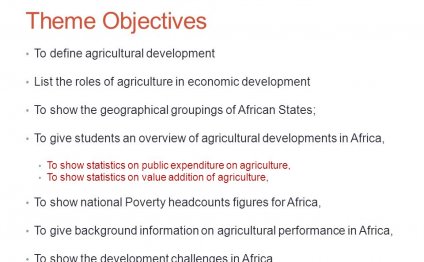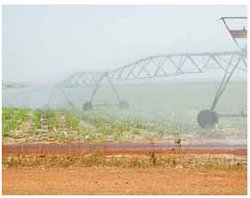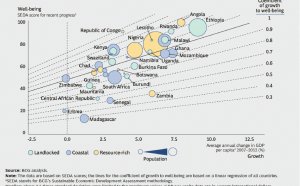
Agricultural Development in Africa

Introduction
Clear-felling of forests for agriculture, post-conflict Liberia, May 2005. (Source: Y. Katerere)Agriculture is a crucial economic activity, providing employment and livelihoods for many and serving as the basis for many industries. About 203 million people, or 56.6 percent of the total labor force, were engaged in agricultural labor in 2002. In most African countries, agriculture supports the survival and well-being of up to 70 percent of the population. Thus, for many, their livelihoods are directly affected by environmental changes, both sudden and gradual, which impact on agricultural productivity.
Livestock and environmental goods offer some security from such shocks. About 70 percent of the rural poor in Africa own livestock, contributing significantly to household and community resilience to disasters, particularly in arid and semi-arid zones. More than 200 million people rely on their livestock for income (sales of milk, meat, skins) and draught power. Overall, livestock contributes about 30 percent of the gross value of agricultural production in Africa. According to the International Livestock Research Centre (ILRI), opportunities exist to commercialize livestock production to target regional deficits in livestock products where they can be produced competitively.
The irony is that, despite the majority of the total labor force working in agriculture, the region is still unable to feed its growing population. For example, between 20 and 75 percent of the population in 29 countries in Central, Western, Eastern and Southern Africa were reported in 2004 to be undernourished. In the Democratic Republic of the Congo (DRC), where 75 percent of the total population of 51 million people were reported to be undernourished, 50 percent of infant mortality is related to malnutrition. Poor nutrition impacts on health, education and the opportunity to participate fully in community and public affairs. Most often women and children carry a disproportionate burden from food insecurity.
Africa spends between US$15 and 20, 000 million on food imports annually, in addition to the US$2, 000 million it receives in food aid annually. These are vast amounts of money that the region can ill afford to externalize, and which could be used to revitalize agriculture, particularly the low-input agriculture whose yields are limited, and thus increase productivity. About 70 percent of Africa’s poor, and at least two-thirds of its population, live in rural areas depending mainly on agriculture and natural resources for their livelihoods.
Agriculture provides the opportunities to address extreme poverty in Africa, where the proportion of people living below the poverty line, of less than US$1 a day, increased from 47.6 percent in 1985 to 59 percent in 2000. As a result, more and more people in Africa have limited access to food and other basic amenities such as potable water, minimum health care and education, effectively limiting the opportunities available to them. Poverty and nutritional status are closely linked. About 26 percent of the people in Africa – more than 200 million people, particularly women and children – are undernourished; this is a reflection of poverty. It deepens other aspects of poverty such as incapacity to work and resistance to disease. It also affects children’s mental development and educational achievements.
 Agriculture is not limited to subsistence food crops and livestock production but includes crops grown for sale, such as tobacco, cotton and flowers. Most agricultural households rely to some extent on sale of agricultural products. Thus, access to markets, finance and supporting infrastructure are crucial.
Agriculture is not limited to subsistence food crops and livestock production but includes crops grown for sale, such as tobacco, cotton and flowers. Most agricultural households rely to some extent on sale of agricultural products. Thus, access to markets, finance and supporting infrastructure are crucial.
Horticulture, which includes vegetables, fruits and cut flowers, has become a major activity. It has grown to be the single largest category in world agricultural trade, accounting for over 20 percent of such trade in recent years. While in sub-Saharan Africa (SSA), horticultural exports now exceed US$2, 000 million, this is only 4 percent of the global total. Significant opportunities for expansion, therefore, exist in Africa to boost employment as well as foreign currency earnings. The challenges would be to adequately deal with environmental problems, which include pollution from chemicals.
An opportunity which is yet to be fully exploited is irrigated agriculture. Only six percent of the total cultivated land is under irrigation in Africa, compared to 33 percent in Asia. In a region where droughts are prevalent, often destroying crops and exacerbating food insecurity, irrigation could be a key factor in enhancing food security. Irrigation increases yields of most crops by between 100 and 400 percent, and it has been projected that in the next three decades, 70 percent of gains in cereal production globally would be from irrigated land. According to the Economic Commission for Africa (ECA), little progress towards sustainable development can be achieved until Africa reaches a minimum level of developing and managing water resources for secure food and agricultural production.
In order to maximize the potential of the agricultural sector, institutional and governance reforms which increase opportunities for rural people, such as better access to finance, and support the development of small and microenterprises is essential. Agricultural opportunities are closely linked to global trade policies and practices.
Boosting agricultural production
Various policy responses have been proposed to reverse the slide in agriculture and help boost production and enhance food security. One of the major responses is the Comprehensive Africa Agriculture Development Programme (CAADP), which was endorsed by African governments in late 2002 in the context of the New Partnership for Africa’s Development (NEPAD). The CAADP has three immediate "pillars" and one long-term pillar which together can help tackle Africa’s agricultural crisis. The mutually reinforcing pillars on which to base the immediate improvement of agriculture, food security and trade balance are:
Irrigation. Large-scale farming in south-western Burkina Faso.(Source: D. Tiveau/CIFOR)
- Extending the area under sustainable land management and reliable water control systems. Building up soil fertility and the moisture-holding capacity of agricultural soils, and rapidly increasing the area under irrigation, especially small-scale irrigation, will not only provide farmers with opportunities to raise output on a sustainable basis, but will also contribute to the reliability of food supplies.
- Improving rural infrastructure and trade-related capacities for market access. Roads, storage, markets, packaging and handling systems, and input supply networks should be improved to raise the competitiveness of local production vis-à-vis imports and export markets.
- Increasing food supply and reducing hunger. Several factors including the limited use of irrigation and other inputs undercut crop and livestock yields. There is a need to improve access to technology by small farmers. These can play a major role in increasing food availability close to where it is most needed, raising rural incomes, and expanding employment opportunities and contributing to growth in exports. Food storage and its protection from mildew and pests are of critical importance. It is also important to respond to the growing frequency and severity of disasters and emergencies which impact on food security. In addition, conflict and war also disrupt food production. As a result, more aid is being diverted to emergency relief than to necessary long-term development.
- Agricultural research, technology dissemination and adoption is the long-term pillar to achieve accelerated gains in productivity and requires:
(Source: Y. Katerere)
RELATED VIDEO



Share this Post
Related posts
Agricultural Development in South Africa
The agriculture sector is of major social and economic importance in the SADC region, contributing in the different Member…
Read MoreDevelopment in African countries
Tax revenues in African countries are rising as a proportion of national incomes, according to the inaugural edition of Revenue…
Read More
 The International Fund for Agricultural Development (IFAD), (Italian: Fondo Internazionale per lo Sviluppo Agricolo), a specialized agency of the United Nations, was established as an international financial institution in 1977 as one of the major outcomes of the...
The International Fund for Agricultural Development (IFAD), (Italian: Fondo Internazionale per lo Sviluppo Agricolo), a specialized agency of the United Nations, was established as an international financial institution in 1977 as one of the major outcomes of the...










